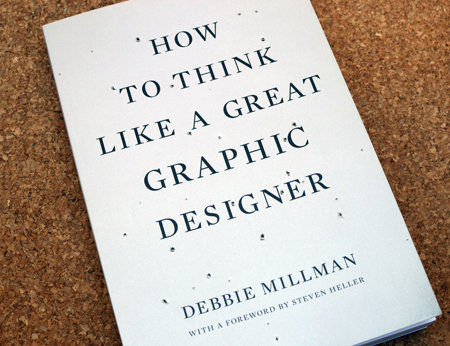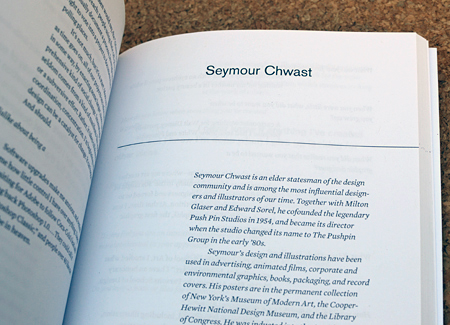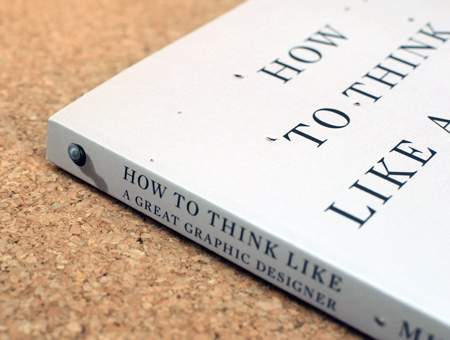How to Think Like a Great Graphic Designer
“I often get questions like this from students, and whenever I do, I get the sense that they are fishing for a recipe to become a successful designer.” Steff Geissbuhler
Critically prefaced via email correspondence by designer Steff Geissbuhler, How to Think Like a Great Graphic Designer by Debbie Millman, claims not to provide a recipe on how to think like the extraordinary designers interviewed in this book but rather proves to be
“a glimpse into the minds of these revered masters, in order to understand the way they think and why.”
Containing an interview line-up that is no doubt a who’s who list of contemporary graphic design, How to Think Like a Great Graphic Designer contains an abundant supply of bravery, audacity, candor, humor, and yes, even inspiration from notables like: Michael Bierut, Neville Brody, Seymor Chwast, Chip Kidd, Milton Glaser, Jessica Hefland, Paula Scher, James Victore, and Massimo Vignelli.
At the beginning of all twenty interviews, Millman provides readers with a brief introduction to each designer’s work (although regrettably there are no visuals for reference), their place in the canon, and a glimpse of their personality, making the book accessible to budding graphic design students, the mid-career designer, and seasoned veterans alike.
In each interview, Millman strikingly inquires about topics one would hope to ask given the opportunity to be in the same room as these design idols. Quintessential questions presented to creatives act as ice-breakers: What was your first creative memory? What did you want to be when you grew up? Do you have any particular creative process? As these mundane questions dissipate, readers are left with what feels like an intimate one on one conversation. By the end of each interview readers learn not only about the interviewees’ passions, concerns, and thoughts on design but also about their personal infatuations, obsessions, oddities, and manifestos.
[I wanted to be] “ A Catholic Priest.” Stefan Sagmeister
“What actually drove me to the therapist was that I had a very unhealthy obsession with laundry.” Michael Bierut
“I have very few “interests.” I have not been to the movies in 12 years. I listen to music at home, but I don’t go to concerts.” Milton Glaser
“Oh my God, how much time do you have? I live in almost constant terror. Here’s a tiny portion of the list: cancer, vaginas, giant cockroaches, Kathy Lee Gifford’s latest Christmas album, burning to death, tornados, gristle, children, choking on a small toy, root rot, Deborah Sussman’s eyelash extensions, Republicans, and Sucralose. And the idea that Pat Robertson is not dead yet.” Chip Kidd
“Love is a cake that comes in layers.” Massimo Vignelli
After just a few interviews a reader can easily find parallels between themselves and these notables, realizing that although they may hold an enduring seat in the canon, they are at the very least humans too - who feel love, pain, passion, and frustration. Millman creates a strong internal dialogue for her audience by questioning a designer’s social responsibility, the difference between design and art, and the dilemma of personal expression vs. commercial endeavor in the industry. One begins to connect their own personal design manifestos with the beliefs of these “great ones” sending an appreciable sense of encouragement, empowerment, and inspiration to every reader.
In addition to constructing strong cognitive connections with viewers the book makes tactile bonds as well. The sleek cover reflects a battered and empty pin board as if all of the ideas, quotes, reflections, and inspiration have been removed and placed neatly between the covers. A perfect size for transport the book is an effortless addition to any designer’s library, providing a jolt of influence with each turn of the page.
A strong balance of logic and lyricism, How to Think Like a Great Graphic Designer is the perfect read after a most horrid client meeting, while battling a formidable creative dilemma, or following an exhausting day of design. In a filling 224 pages, Millman and her eminent cast provide readers with a robust reminder of how and why we fell in love with this arduous yet delectable profession.
How to Think Like a Great Graphic Designer is published by Allworth Press and can be purchased from Amazon (US | CA | UK | DE).
About the Reviewer Jenny Venn is a designer and professor who packed up everything and headed west determined to change the world through education and activism. Find her work at studiojenvenn, her thoughts at @jenvenn, and her calling at uwyo.





